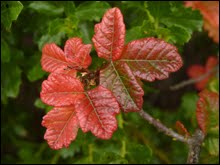 |
Mature coast live oaks may become a relic of the past; they are susceptible to a single-celled, infectious organism called a water mold. Coast live oaks are especially susceptible when situated close to California bay laurel trees.
Leaving a million dead trees in its wake, the epidemic of Sudden Oak Death (SOD) in California continues onward. How did this disease, first noted in Marin County tan oaks less than 20 years ago, take such a swift and massive toll on the central California landscape?
Speaking in November of 2012 at Stanford's Jasper Ridge Biological Preserve, Stuart Koretz, MD, PhD, addressed this topic from an epidemiological and general scientific point of view.
An infectious agent, a susceptible population, a mode of transmission, and a reservoir of infection are all part of the Sudden Oak Death epidemic, noted Koretz, who has reviewed considerable literature on the subject and has been a participant in the citizen scientist effort to support monitoring and research.
Grouped with organisms called "water molds" and classified as Oomycetes in kingdom Protoctista, the infectious single-celled Phytophthora ramorum bears some characteristics typical of fungi, for example filamentous growth. However, these similarities are likely a result of convergent evolution rather than proximity on the tree of life. In other words, subject to similar environmental challenges over evolutionary time, the water molds found some of the same survival solutions that fungi did, thus developing similar structures.
A healthy evergreen forest with mature oaks in abundance.
A mind-boggling number of diverse plant species are infected by P. ramorum, ranging from the coast redwood (Sequoia sempervirens) – the world's tallest tree – to the pungent broadleaf tree California bay laurel (Umbellularia californica) and understory plants such as Rhododendron, sp., poison oak (Toxicodendron diversilobum), and wood fern (Dryopteris arguta). Importantly, the pathogen also infects key components of oak and mixed woodlands throughout Central California—tanbark oaks (Lithocarpus densiflora) and two of the oaks in the red oak lineage (subgenus Erythrobalanus), coast live oak (Quercus agrifolia) and black oak (Quercus kelloggii).
But while these oaks have
taken a big hit, most other infected species show more subtle effects. For
example, infected redwoods may display dead needles and sometimes entirely dead twigs, while infected bays may exhibit leaves with brownish tips. In
contrast, the trunks of infected oaks become girdled with cankers. This affects
vascular cambium – the growth layer of a tree trunk – as well as the transport
systems for sap (phloem) and water (xylem), which are located near the
periphery of the trunk close to the bark (as opposed to in the interior of the
tree, which basically serves structural purposes). Thus the rapidly reproducing
single-celled water mold may fell, within just a few years of initial
infection, grand, well-established trees that grew for decades or even
centuries.
The first clues that an epidemic was underway surfaced in Marin County in 1995, according to the synopsis presented by Koretz. Tanoaks were dying, typically with oozing cankers towards the base of the trunk. Bark and ambrosia beetles drilling the dead and moribund trees left telling piles of sawdust; black golf balls of hypoxylon fungus, a signature of tree death, studded the limbs. By 1997, coast live oaks were also declining, bearing similar hallmarks of infection.
The disease became visible in black oaks, as well as spreading geographically, in 1998, leading to a major collaborative effort to identify the culprit organism, according to Koretz. This joint effort involved the University of California (UC), Berkeley, UC Davis, and the USDA Forest Service, among many others. By 2001, Marin County had declared a state of emergency, and task forces had formed both in California and Oregon (where there was now a localized "pinpoint" infection). Scientists showed definitively that the causal organism was Phytophthora ramorum by fulfilling Koch's postulates: The organism was present in every case examined, it was isolated in pure culture, inoculation into healthy plant tissue produced the same disease, the organism was then isolated from the experimentally infected plants.
Continued investigation
revealed a complex epidemiology. Researchers determined that the original
source was most likely infected nursery stock possibly originating from a
foreign location. Many plants were involved, including several tree
species as well as understory herbs, shrubs, and vines, ranging across plant
families as diverse as ferns and heaths. Most, though symptomatic, survived
infection, at least as mature plants. But some of these living reservoirs shed
large numbers of infectious asexual spores.
The California bay laurel
turned out to be a major source of the infection, both harboring the water mold
and shedding copious quantities of spores after warm spring rains. Proximity of
bays to coast live oaks in Coast Range evergreen forests spread the infection
through spore-loaded rain drip onto oak tree trunks, where inoculum stuck to
the rough bark. While the infection did not move easily from one coast live oak
to another, tanoaks both died of the infection and spread the infectious agent.
Researchers and agencies,
with the assistance of citizen scientist volunteers, continue to monitor the
infection, through ground and aerial surveys. In "stream-baiting," uninfected
plant material is exposed to flowing waters potentially transporting the water
mold from upstream watersheds. Strict controls are now in place on moving
infected wood or soil, and on the distribution of nursery stock. –Anne M. Rosenthal
To view a map of the
infection, see the following web site:
A general reference, including photos of
infected plants, is available through the California Oak Mortality Talk Force:

























